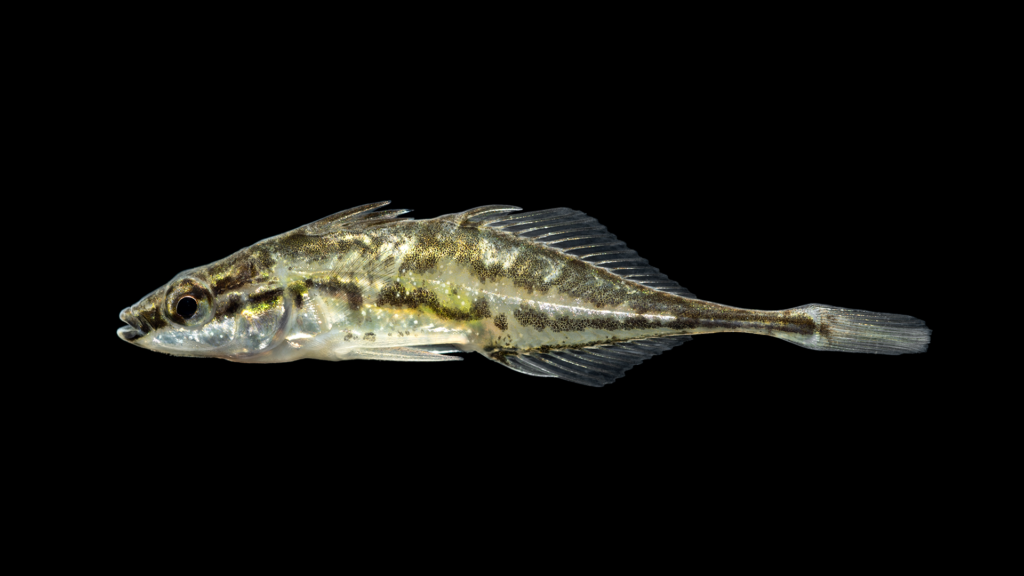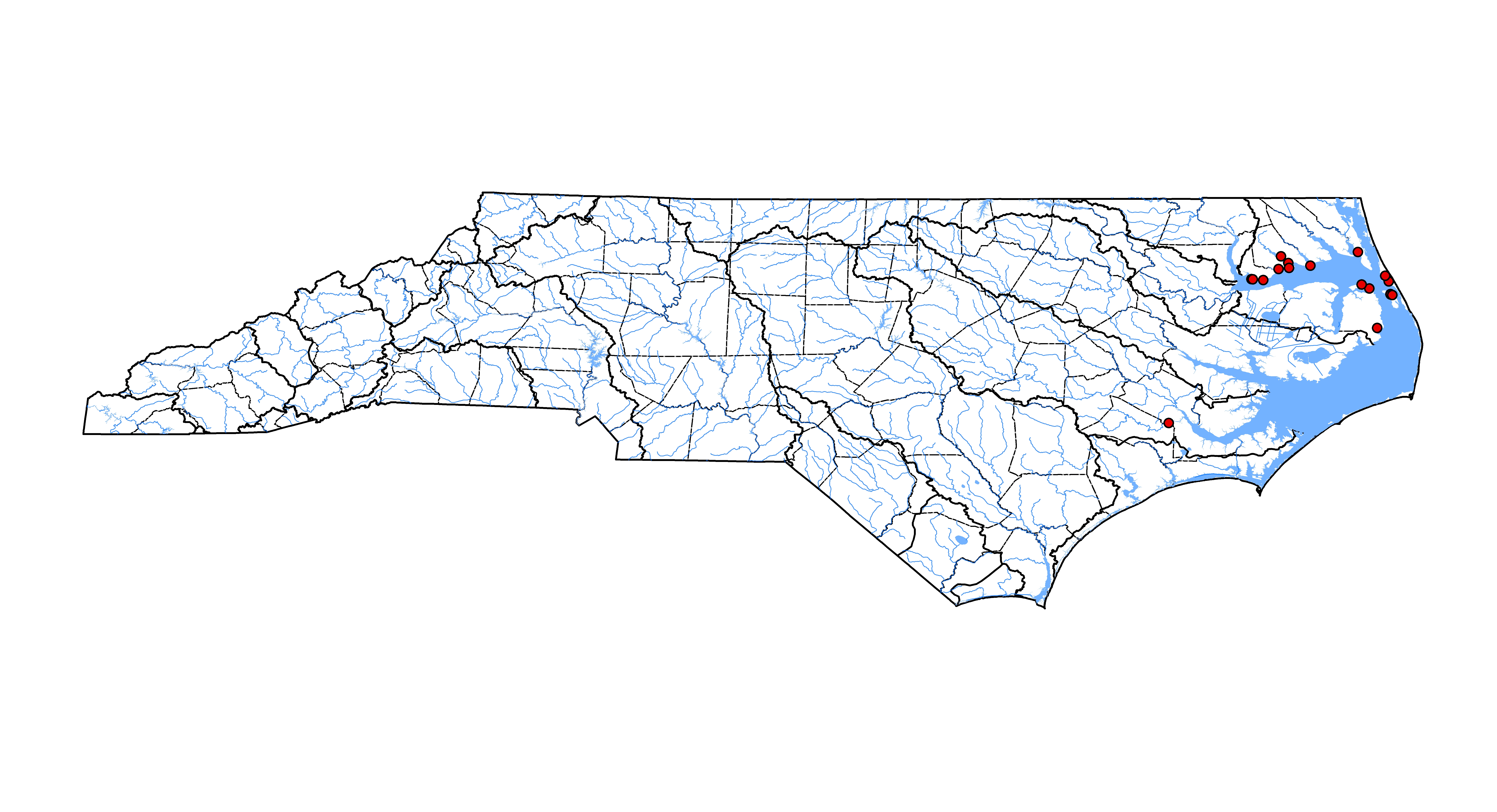By the NCFishes.com Team
How did this fish, the smallest member of the Stickleback family, get here? And when?
As written in our previous blog on sticklebacks (https://ncfishes.com/is-north-carolina-too-far-south-for-sticklebacks/), Dr. Hugh M. Smith, U.S. Commissioner of Fisheries, in 1907 made no mention of Fourspine Stickleback (Figure 1) in the Albemarle or Pamlico sounds (Smith 1907). In addition, intensive surveys conducted by staff of North Carolina State University, the North Carolina Wildlife Resources Commission (NCWRC), and University of North Carolina’s Institute of Fisheries Research during the 1940s-1960s failed to detect any populations of this species in these areas (Baker and Smith 1965a, 1965b; Carnes 1965; Sincock et al. 1965; Smith 1963).

We thought that Fourspine Stickleback was not discovered in North Carolina’s waters until 1975 when the first specimen was collected from Stumpy Point Bay off Pamlico Sound in Dare County by staff of the North Carolina Division of Marine Fisheries (NCDMF) (Florida Museum of Natural History, UF Catalogue No. 30593). The first reported and account of its occurrence in North Carolina waters was in a paper in 1979 – Freshwater fishes of Croatan National Forest – by Fred C. Rohde and others (Rohde et al. 1979) and was based upon a single specimen collected in 1977 from the Trent River, near New Bern, Jones County (North Carolina Museum of Natural Sciences, NCSM Catalogue No. 74386). Then, a third specimen was netted in 1978 from Shallowbag Bay on Roanoke Island, Dare County, again by NCDMF staff (UF Catalogue No. 30670).
This spring Jim Borawa, who is retired from the NCWRC, brought to our attention a report by Thomas Crowell published in 1968 that pushes back the first detection of this species in North Carolina from 1975 to sometime between 1959 and 1966 in Currituck Sound (Crowell 1968). It was detected in the sound via the use of rotenone by NCWRC staff somewhere between Knapp’s Pond in Great Marsh and Hog Quarter Creek in Currituck County.
Fourspine Stickleback may have been introduced into the sound via Knotts Island Bay (NC) and Back Bay (VA) in the early-mid 1960s when raw sea water was being pumped by Virginia Beach, VA (at a rate of ~ 36 million gallons per day) to precipitate out an increase in suspended solids and the resultant turbidity that had occurred from changing land use practices in the watershed and loss of native submerged aquatic vegetation; or in 1962 when natural breaches in the barrier islands occurred during the Ash Wednesday Storm; or by the emptying of boats’ ballast and live bait wells; or the dumping of bait buckets at the end of a day’s fishing.
We may never know if Fourspine Stickleback was introduced or moved via natural dispersal from more northerly populations along the Atlantic coast, but we do know that it is now a permanent resident within the Currituck, Albemarle, Roanoke, Croatan, and Pamlico sounds (Map 1) in North Carolina and has been here since possibly 1959.

References and Resources
Baker, W.D., and W.B. Smith. 1965a. Survey and classification of the Perquimans-Pasquotank-North Rivers and tributaries, North Carolina. Final Report, Federal Aid in Fish Restoration, Job I–R, Project F–14–R. North Carolina Wildlife Resources Commission. Raleigh, NC.
Baker, W.D., and W.B. Smith. 1965b. Survey and classification of the Scuppernong–Alligator Rivers and tributaries, North Carolina. Final Report, Federal Aid in Fish Restoration, Job I–S, Project F–14–R. North Carolina Wildlife Resources Commission. Raleigh, NC.
Carnes, W.C. 1965. Survey and classification of the Roanoke River and tributaries, North Carolina. Final Report, Federal Aid in Fish Restoration, Job I–Q, Project F–14–R. North Carolina Wildlife Resources Commission. Raleigh, NC.
Crowell, T.E. 1968. Fish – Management Research. Work Plan I Currituck Sound Investigations. Job I-A – Job I-H. Federal Aid in Fish Restoration, Project F-16-R. Final Report. North Carolina Wildlife Resources Commission. Raleigh, NC.
Rohde, F.C., G.H. Burgess, and G.W. Link, Jr. 1979. Freshwater fishes of Croatan National Forest, North Carolina, with comments on the zoogeography of Coastal Plain fishes. Brimleyana 2:97-118.
Sincock, J. L., K.E. Johnston, J.L. Coggin, R.E. Wollitz, J.A. Kerwin, and J.Grandy. 1965. Back Bay-Currituck Sound data report. Volume 4. Fish studies. U.S. Fish & Wildlife Service, North Carolina Wildlife Resources Commission, and Virginia Commission of Game and Inland Fisheries. 225p.
Smith, H.M. 1907. The fishes of North Carolina. North Carolina Geological and Economic Survey, Raleigh, NC. Volume 2. 453p.
Smith, W.B. 1963. Survey and classification of the Chowan River and tributaries, North Carolina. Final Report, Federal Aid in Fish Restoration, Job I–F, Project F–14–R. North Carolina Wildlife Resources Commission. Raleigh, NC.
Tracy, B.H., F.C. Rohde, and G.M. Hogue. 2020. An annotated atlas of the freshwater fishes of North Carolina. Southeastern Fishes Council Proceedings No. 60. 198p. (Available at: https://trace.tennessee.edu/sfcproceedings/vol1/iss60/1).